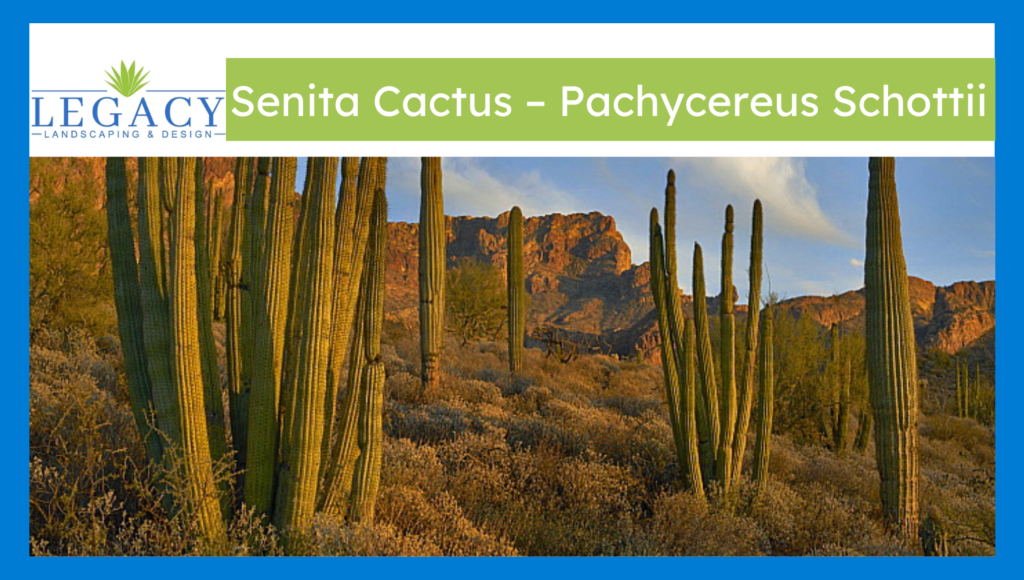| SR# | Characteristic | Description |
| 1 | Size | 10 to 20 feet tall. |
| 2 | Appearance | Tall, columnar cactus with numerous, spiny branches. |
| 3 | Spines | Short, light-colored spines covering stems. |
| 4 | Flowers | White or pink flowers, typically at the top of branches. |
| 5 | Fruits | Red to purple, edible fruits, sweet taste. |
| 6 | Root System | Deep, water-conserving roots. |
| 7 | Lifespan | Up to 100 years. |
| 8 | Habitat | Deserts, often in rocky areas and dry hillsides. |
| 9 | Water Storage | Stores water in the thick stems. |
| 10 | Growth Rate | Moderate, up to 6 inches per year. |
| 11 | Flowering Time | Spring to early summer. |
| 12 | Reproduction | Seeds dispersed by animals and birds. |
The senita cactus (Pachycereus schottii) exists naturally in northern Mexico and southern Arizona while growing at a slow pace as a columnar cactus type. The senita cactus reaches a height of 4.5 meters through the growth of multiple ribbed stems that become crowned with grayish and hairy spines near their tips. When it blooms during late spring and summer the cactus produces night-flowering pale pink to white petals that result in tiny edible red fruits. It succeeds best when planted in rocky terrain which requires good drainage and experiences full sun exposure with outstanding performance during dry seasons. The Senita cactus maintains an essential position in its native environment because organisms from local wildlife groups and pollinators depend on its habitat structure. The cactus supports a symbiotic connection between itself and the rare Senita moth.
Table of Contents
How to Grow a Senita Cactus from a Branch?
You can transform an ordinary Senita cactus branch into an independent plant by picking an appropriate branch and waiting for it to create a callus through contact with air for several days before planting it. The drying period prevents rot from attacking before planting occurs. After drying, place the branch into well-draining cactus soil with a few inches of burying to establish stability. Expose your pot to sunny conditions because Senita cacti want bright light which mirrors arid environmental conditions. Water your plantings only when the soil becomes entirely dry. Afterwards, the roots develop creating a healthy mature cactus as the branch establishes itself.
How to Plant a Senita Cactus?
Successful growth of the Senita cactus needs sunny conditions combined with well-draining soil in its planting site. Plant the cactus in a hole that measures somewhat larger than its root area. Before planting a cutting, allow the cut area to dry out for several days so rot prevents development. Insert the cactus or cut through the hole at proper height then carefully surround the base with soil to provide support stabilization. The planting should be watered gently right after burying but the soil needs to be completely dry before administering another hydration. Through environmental acclimation, the cactus develops into a self-sufficient plant that maintains health without requiring much care while becoming established in dry hot environments.
What Eats a Senita Cactus?
The Senita cactus serves as a fundamental resource for desert animals by delivering water combined with natural sugars, fiber, fats and proteins. The cactus stem’s juicy tissue retains vital water which maintains hydration for jackrabbits and pack rats and supplies them with energizing natural sugar. The fiber-containing cactus functions as a digestive aid for ground squirrels alongside other desert species. Seeds from the Senita cactus contain fats and proteins that feed moth larvae successfully. The cactus stems attract some bird species like woodpeckers who break the stems to get both water and nutrients. Botanic Gardens in Arizona recognize the essential functions of this mineral-rich cactus that sustains desert wildlife populations.
How Does the Senita Cactus Help the Senita Moth?
The Senita cactus maintains essential aspects of Senita moth survival through a complex mutualistic bond. The cactus serves two critical functions as a protective habitat combined with a nutritional supply for the moth. When mature Senita female moths enter cactus flowers the eggs they produce later hatch into larvae which consume seed contents from the plant. While the flowers of the cactus provide nectar for adult moths. The collaboration guarantees the protected progression of the moth’s developmental cycle. During its visits, the moth performs pollination activities that help the cactus reproduce. Two species engage in an adaptive network that displays nature’s precise equilibrium since they jointly need the other species to prosper and reproduce.
About The Author
Isaiah Espinoza
Isaiah Espinoza is the proud company owner, founder and driving force behind Legacy Landscaping and Design. Isaiah established Legacy Landscaping & Design in 2014, bringing his vision of creating stunning outdoor spaces to life. Isaiah, the founder of Legacy Landscaping & Design, has a deep-rooted passion for construction and design, stemming from four generations of family expertise in the industry. With a KB-1 General Building License and a CR-21 Hardscaping and Irrigation License, Isaiah has spent the past decade transforming outdoor spaces with exceptional craftsmanship and innovative design.

